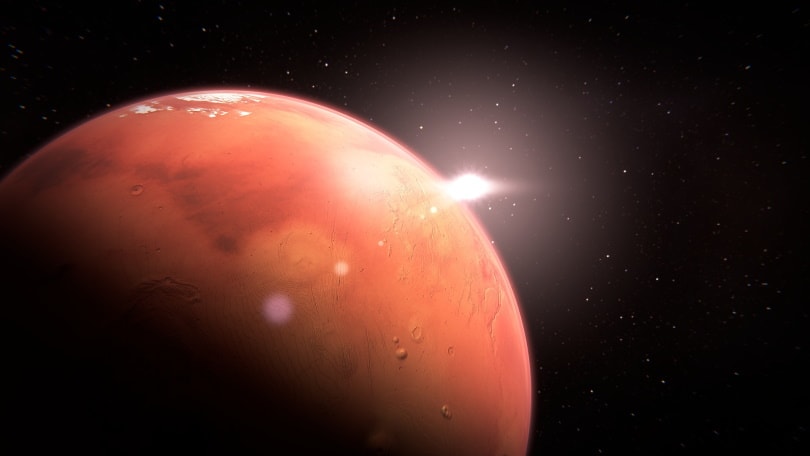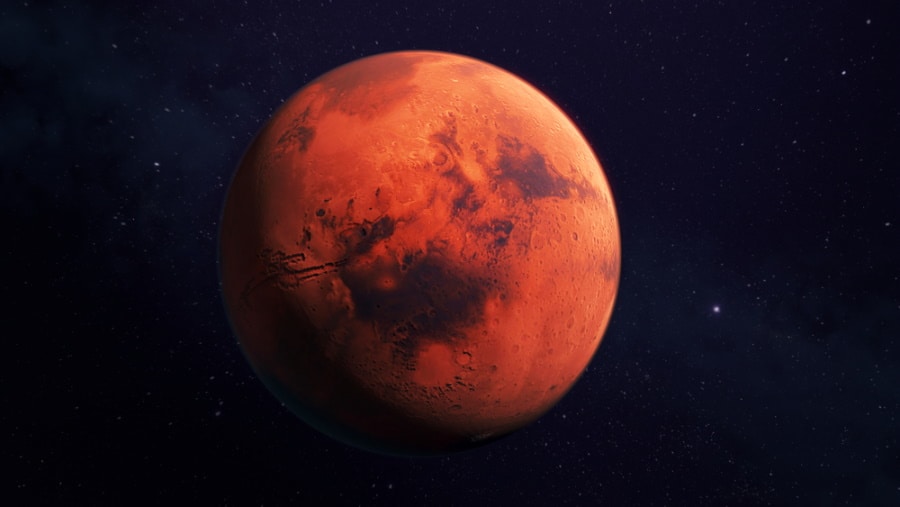10 Interesting Facts About Mars’ Moons You Never Knew (With Pictures)
Last Updated on

Mars is commonly known as the ‘Red Planet’ because it’s covered in dust and rocks made of iron oxide—a chemical compound that’s rusty red in color. You might also have heard astronomers refer to it as the ‘god of war.’ The same name as Jupiter and Juno’s son who, according to ancient Roman religion and myths was a military god and an agricultural guardian.
But that’s not our topic of discussion today. We’re here to share with you some of the incredible facts that we’ve learned about Deimos and Phobos—the two moons of Mars that still remain a mystery to mankind.

The 10 Interesting Facts About the Martian Moons
1. The origin of the Martian moons is a mystery
We’re still not so sure how these two satellites came into existence. The best that our experienced astronomers could do is speculate or come up with various theories. For instance, some people are of the opinion that Mars collided with another planet in the past, and as a result, molten rocks were formed and released into the solar system.
But the gravitational pull from the planet was so strong that it compelled them to form large clumps that later on became Deimos and Phobos. Proponents of this theory have even gone as far as arguing that they cannot be wrong, seeing as the rocks found on the moon have the same mineral composition as those found on Mars.
The asteroid belt between Jupiter and Mars is also thought to be the origin of the Deimos and Phobos. Since the asteroids that make up that belt are C-type carbonaceous, some astronomers believe the two moons somehow managed to escape captivity and be part of the Martian system. A phenomenon that they describe as the ‘Asteroid Capture.’

2. They were once considered asteroids
Deimos and the Phobos are not your typical moons. They have meteorite-like compositions and irregular shapes. That’s why it took so long for scientists to realize Mars has not one but two moons.
It’s not unlikely for asteroids to be caught by a gravitational pull. These two moons did fit the profile, as they had a potato shape, cratered surface, and a non-Martian composition. The only thing that puzzled the experts at that time was their respective orbits.
3. Asaph Hall discovered Mars’ moons
Born in 1829, Asaph Hall was an astronomer famously known for discovering that Mars has an inner and outer moon. If you look at the records, you’ll learn that he’s also the guy who calculated their orbits.
Mr. Hall had been studying the planet for years. He invested a huge chunk of his time trying to prove Mars has a satellite the same way Earth does, but it got to a point his hopes started dwindling. He eventually threw in the towel, but his wife, Chloe Angeline Stickney Hall, egged him on. And in 1877, he got the chance to write his name in the history books.
4. Henry George Madan named the moons
Henry George Madan was a renowned English teacher and a chemist and it’s safe to assume he also had a passion for Greek mythology. Deimos and Phobos are mythological twin characters who were always by their father’s side in battle.
Thanks to Homer’s ancient poem, ‘The Iliad,’ we now know Phobos was a Greek deity who represented fear, while his twin brother Deimos was the personification of terror.
Ares was the war god in Greek mythology. So, since planet Mars was already named after the Roman equivalent, Henry felt like it was only right to name the moons after the sons.
5. Phobos has been dubbed the ‘Doomed Martian Moon’
For the past couple of decades, astronomers have been working nonstop to try to discover other forms of life in the galaxy. And during one of the trips made by the Mars rovers, they realized from the data collected that Phobos had been inching closer to the red planet.
They’ve speculated that in the next 50 or so million years, it will either disintegrate and create a ring around Mars (just like the one seen around Saturn) or just strike it and disintegrate into tiny bits and pieces. Hence the moniker, the ‘Doomed Martian Moon.’
6. Mars’ moons aren’t visible from its surface
The distance between our planet and its moon is 238,855 miles. This distance is long enough to allow us to be able to spot the moon from our surface. But the case with Mars is different. Even though both moons are still visible, they can only be sighted in the planet’s equatorial regions. The Deimos looks like a star, while the Phobos resembles a static asteroid.
7. Martian moons travel in the same direction as the Earth-moon
Our moon’s orbital velocity is 0.635 miles/s, and it travels from west to east. The Deimos and Phobos also revolve their planet in that same direction, but at a speed of 3,022.7 mph and 4,782.5 mph respectively.
8. Mars’ moons haven’t changed orbits for billions of years
Typically, asteroids don’t have stable orbits. The atmospheric pressure always finds a way to force them to change direction or move away. Fortunately for Mars, its atmosphere is thin and insufficient. That’s why any captured asteroid next to it often finds it easy to settle into its present orbit.
9. Deimos and Phobos are relatively small
The two Mars moons are not as large as some people think. As per the information gathered by our planetary experts, Deimos has a diameter of 7.8 miles while that of Phobos is 13.8 miles.
To put that into context, the earth’s radius is 1,079.6 miles, making its diameter 2,159.2 miles. The largest moon in our solar system is the Ganymede, which is owned by Jupiter. Its diameter is 3,273.5 miles, meaning it’s even larger than planet Mercury.
10. Deimos and Phobos have different orbital revolution time
First off, Phobos is a lot closer to the planet than Deimos. Experts have been able to calculate the distance as 3,700 miles, and 14,576 miles respectively. It’s the reason why Deimos takes roughly 30 hours to complete a single orbital revolution, while Phobos only needs 7.66 hours. And because a day on the red planet is equivalent to 24 hours and 37 minutes, Phobos is able to circle it three times before the day ends.

Frequently Asked Questions
Were the Martian moons a single proto moon?
That’s what the experts at the Swiss Federal Institute of Technology believe. They did some research in tandem with the US Naval Observatory and concluded that those two moons must have been parts of a single proto moon. A “proto moon” is a scientific term used to describe a moon that’s still developing.
Does Phobos have any craters?
Yes, it does. It’s known as the Stickney crater, and it’s approximated to be 6 miles wide. Its twin brother Deimos also boasts of having two craters. They are called the Swift and Voltaire craters, and they each have a 1.9-mile diameter.
Has any rover ever landed on any Martian moon?
Sadly, no. We’ve never had a rover land on any one of those moons because they always face different obstacles. The pictures and the data collected have been gotten from rovers that landed on the red planet. But if the rumors are true, the Japanese Space Agency will be sending one of their lander aircraft to collect soil samples and rocks. That would be in 2024.

Conclusion
The planetary science community is heavily invested in these sorts of projects because it believes the Martian moons may provide answers to the questions that we’ve been riddled with for eons. It’s taken centuries to get to where we are today, but the steps made are tremendous. That’s how we know we’re heading in the right direction.
See also:
- How Long Is a Day on Uranus?
- How Many Moons Does Mars Have?
- How Many Rings Does Jupiter Have?
- How Big is Uranus?
Featured Image Credit: Colin Behrens, Pixabay
Table of Contents
- The 10 Interesting Facts About the Martian Moons
- 1. The origin of the Martian moons is a mystery
- 2. They were once considered asteroids
- 3. Asaph Hall discovered Mars’ moons
- 4. Henry George Madan named the moons
- 5. Phobos has been dubbed the ‘Doomed Martian Moon’
- 6. Mars’ moons aren’t visible from its surface
- 7. Martian moons travel in the same direction as the Earth-moon
- 8. Mars’ moons haven’t changed orbits for billions of years
- 9. Deimos and Phobos are relatively small
- 10. Deimos and Phobos have different orbital revolution time
- Frequently Asked Questions
- Conclusion
About the Author Robert Sparks
Robert’s obsession with all things optical started early in life, when his optician father would bring home prototypes for Robert to play with. Nowadays, Robert is dedicated to helping others find the right optics for their needs. His hobbies include astronomy, astrophysics, and model building. Originally from Newark, NJ, he resides in Santa Fe, New Mexico, where the nighttime skies are filled with glittering stars.
Related Articles:
Monocular vs Telescope: Differences Explained (With Pictures)
15 Crucial Facts About Ultraviolet Rays & the Sun
What Constellation Is Spica In? The Interesting Answer!
10 Interesting Leo Constellation Facts, Myths, and FAQs
15 Interesting Pegasus Constellation Facts, Myths, and FAQs
6 Interesting Sagittarius Constellation Facts, Myths, and FAQs in 2024!
What Are Constellations? Where Did They Come From?
8 Interesting Libra Constellation Facts, Myths, and FAQs
